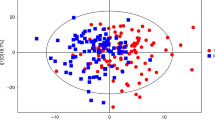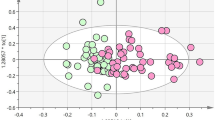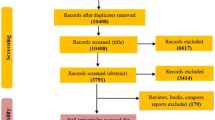Abstract
Objectives:
Mechanisms of the development of abnormal metabolic phenotypes among obese population are not yet clear. In this study, we aimed to screen metabolomes of both healthy and subjects with abnormal obesity to identify potential metabolic pathways that may regulate the different metabolic characteristics of obesity.
Methods:
We recruited subjects with body mass index (BMI) over 25 from the weight-loss clinic of a central hospital in Taiwan. Metabolic healthy obesity (MHO) is defined as without having any form of hyperglycemia, hypertension and dyslipidemia, while metabolic abnormal obesity (MAO) is defined as having one or more abnormal metabolic indexes. Serum-based metabolomic profiling using both liquid chromatography–mass spectrometry and gas chromatography–mass spectrometry of 34 MHO and MAO individuals with matching age, sex and BMI was performed. Conditional logistic regression and partial least squares discriminant analysis were applied to identify significant metabolites between the two groups. Pathway enrichment and topology analyses were conducted to evaluate the regulated pathways.
Results:
A differential metabolite panel was identified to be significantly differed in MHO and MAO groups, including L-kynurenine, glycerophosphocholine (GPC), glycerol 1-phosphate, glycolic acid, tagatose, methyl palmitate and uric acid. Moreover, several metabolic pathways were relevant in distinguishing MHO from MAO groups, including fatty acid biosynthesis, phenylalanine metabolism, propanoate metabolism, and valine, leucine and isoleucine degradation.
Conclusion:
Different metabolomic profiles and metabolic pathways are important for distinguishing between MHO and MAO groups. We have identified and discussed the key metabolites and pathways that may prove important in the regulation of metabolic traits among the obese, which could provide useful clues to study the underlying mechanisms of the development of abnormal metabolic phenotypes.
This is a preview of subscription content, access via your institution
Access options
Subscribe to this journal
Receive 12 print issues and online access
$259.00 per year
only $21.58 per issue
Buy this article
- Purchase on Springer Link
- Instant access to full article PDF
Prices may be subject to local taxes which are calculated during checkout



Similar content being viewed by others
References
Mokdad AH, Serdula MK, Dietz WH, Bowman BA, Marks JS, Koplan JP . The spread of the obesity epidemic in the United States, 1991-1998. JAMA 1999; 282: 1519–1522.
Aguilar-Salinas CA, Garcia EG, Robles L, Riano D, Ruiz-Gomez DG, Garcia-Ulloa AC et al. High adiponectin concentrations are associated with the metabolically healthy obese phenotype. J Clin Endocrinol Metab 2008; 93: 4075–4079.
Wildman RP, Muntner P, Reynolds K, McGinn AP, Rajpathak S, Wylie-Rosett J et al. The obese without cardiometabolic risk factor clustering and the normal weight with cardiometabolic risk factor clustering: prevalence and correlates of 2 phenotypes among the US population (NHANES 1999-2004). Arch Intern Med 2008; 168: 1617–1624.
Hamer M, Stamatakis E . Metabolically healthy obesity and risk of all-cause and cardiovascular disease mortality. J Clin Endocrinol Metab 2012; 97: 2482–2488.
Appleton SL, Seaborn CJ, Visvanathan R, Hill CL, Gill TK, Taylor AW et al. Diabetes and cardiovascular disease outcomes in the metabolically healthy obese phenotype: a cohort study. Diabetes Care 2013; 36: 2388–2394.
Karelis AD, Faraj M, Bastard JP, St-Pierre DH, Brochu M, Prud'homme D et al. The metabolically healthy but obese individual presents a favorable inflammation profile. J Clin Endocrinol Metab 2005; 90: 4145–4150.
Brochu M, Tchernof A, Dionne IJ, Sites CK, Eltabbakh GH, Sims EA et al. What are the physical characteristics associated with a normal metabolic profile despite a high level of obesity in postmenopausal women? J Clin Endocrinol Metab 2001; 86: 1020–1025.
Preet A, Karve TM, Rizk N, Cheema AK . Metabolomics: approaches and applications to diabetes research. J Diabetes Metab 2012; S6: 001.
Connor SC, Hansen MK, Corner A, Smith RF, Ryan TE . Integration of metabolomics and transcriptomics data to aid biomarker discovery in type 2 diabetes. Mol BioSyst 2010; 6: 909.
Gu S, A J, Wang G, Zha W, Yan B, Zhang Y et al. Metabonomic profiling of liver metabolites by gas chromatography-mass spectrometry and its application to characterizing hyperlipidemia. Biomed Chromatogr 2010; 24: 242–252.
Kim JY, Park JY, Kim OY, Ham BM, Kim H-J, Kwon DY et al. Metabolic profiling of plasma in overweight/obese and lean men using ultra performance liquid chromatography and Q-TOF mass spectrometry (UPLC-Q-TOF MS). J Proteome Res 2010; 9: 4368–4375.
Mihalik SJ, Goodpaster BH, Kelley DE, Chace DH, Vockley J, Toledo FGS et al. Increased levels of plasma acylcarnitines in obesity and type 2 diabetes and identification of a marker of glucolipotoxicity. Obesity (Silver Spring) 2009; 18: 1695–1700.
Mihalik SJ, Michaliszyn SF, de Las Heras J, Bacha F, Lee S, Chace DH et al. Metabolomic profiling of fatty acid and amino acid metabolism in youth with obesity and type 2 diabetes: evidence for enhanced mitochondrial oxidation. Diabetes Care 2012; 35: 605–611.
Wang C, Feng R, Sun D, Li Y, Bi X, Sun C . Metabolic profiling of urine in young obese men using ultra performance liquid chromatography and Q-TOF mass spectrometry (UPLC/Q-TOF MS). J Chromatogr B Analyt Technol Biomed Life Sci 2011; 879: 2871–2876.
Tan C-E, Ma S, Wai D, Chew S-K, Tai E-S . Can we apply the National Cholesterol Education Program Adult Treatment Panel definition of the metabolic syndrome to Asians? Diabetes Care 2004; 27: 1182–1186.
Kuk JL, Ardern CI . Are metabolically normal but obese individuals at lower risk for all-cause mortality? Diabetes Care 2009; 32: 2297–2299.
Ho TJ, Kuo CH, Wang SY, Chen GY, Tseng YJ . True ion pick (TIPick): a denoising and peak picking algorithm to extract ion signals from liquid chromatography/mass spectrometry data. J Mass Spectrom 2013; 48: 234–242.
Bartel J, Krumsiek J, Theis FJ . Statistical methods for the analysis of high-throughput metabolomics data. Comput Struct Biotechnol J 2013; 4: e201301009.
Dunn WB, Erban A, Weber RJM, Creek DJ, Brown M, Breitling R et al. Mass appeal: metabolite identification in mass spectrometry-focused untargeted metabolomics. Metabolomics 2012; 9: 44–66.
Kanehisa M, Goto S, Sato Y, Furumichi M, Tanabe M . KEGG for integration and interpretation of large-scale molecular data sets. Nucleic Acids Res 2011; 40: D109–D114.
Xia J, Wishart DS . MetPA: a web-based metabolomics tool for pathway analysis and visualization. Bioinformatics 2010; 26: 2342–2344.
Eaton S, Bartlett K, Pourfarzam M . Mammalian mitochondrial beta-oxidation. Biochem J 1996; 320: 345–357.
Gall WE, Beebe K, Lawton KA, Adam K-P, Mitchell MW, Nakhle PJ et al. α-Hydroxybutyrate is an early biomarker of insulin resistance and glucose intolerance in a nondiabetic population. PLoS ONE 2010; 5: e10883.
Newgard CB, An J, Bain JR, Muehlbauer MJ, Stevens RD, Lien LF et al. A branched-chain amino acid-related metabolic signature that differentiates obese and lean humans and contributes to insulin resistance. Cell Metab 2009; 9: 311–326.
Wahl S, Yu Z, Kleber M, Singmann P, Holzapfel C, He Y et al. Childhood obesity is associated with changes in the serum metabolite profile. Obes Facts 2012; 5: 660–670.
Tai ES, Tan ML, Stevens RD, Low YL, Muehlbauer MJ, Goh DL et al. Insulin resistance is associated with a metabolic profile of altered protein metabolism in Chinese and Asian-Indian men. Diabetologia 2010; 53: 757–767.
Shaham O, Wei R, Wang TJ, Ricciardi C, Lewis GD, Vasan RS et al. Metabolic profiling of the human response to a glucose challenge reveals distinct axes of insulin sensitivity. Mol Syst Biol 2008; 4: 214.
Kirchberg FF, Harder U, Weber M, Grote V, Demmelmair H, Peissner W et al. Dietary protein intake affects amino Acid and acylcarnitine metabolism in infants aged 6 months. J Clin Endocrinol Metab 2015; 100: 149–158.
Wang TJ, Larson MG, Vasan RS, Cheng S, Rhee EP, McCabe E et al. Metabolite profiles and the risk of developing diabetes. Nat Med 2011; 17: 448–453.
Lynch CJ, Adams SH . Branched-chain amino acids in metabolic signalling and insulin resistance. Nat Rev Endocrinol 2014; 10: 723–736.
Ritov VB, Menshikova EV, He J, Ferrell RE, Goodpaster BH, Kelley DE . Deficiency of subsarcolemmal mitochondria in obesity and type 2 diabetes. Diabetes 2005; 54: 8–14.
Schwab MA, Sauer SW, Okun JG, Nijtmans LGJ, Rodenburg RJT, van den Heuvel LP et al. Secondary mitochondrial dysfunction in propionic aciduria: a pathogenic role for endogenous mitochondrial toxins. Biochem J 2006; 398: 107–112.
Dweikat IM, Naser EN, Abu Libdeh AI, Naser OJ, Abu Gharbieh NN, Maraqa NF et al. Propionic acidemia mimicking diabetic ketoacidosis. Brain Dev 2011; 33: 428–431.
Foster DW . Malonyl-CoA: the regulator of fatty acid synthesis and oxidation. J Clin Invest 2012; 122: 1958–1959.
Bandyopadhyay GK, Yu JG, Ofrecio J, Olefsky JM . Increased malonyl-CoA levels in muscle from obese and type 2 diabetic subjects lead to decreased fatty acid oxidation and increased lipogenesis; thiazolidinedione treatment reverses these defects. Diabetes 2006; 55: 2277–2285.
Mracek T, Drahota Z, Houstek J . The function and the role of the mitochondrial glycerol-3-phosphate dehydrogenase in mammalian tissues. Biochim Biophys Acta 2013; 1827: 401–410.
Swierczynski J, Zabrocka L, Goyke E, Raczynska S, Adamonis W, Sledzinski Z . Enhanced glycerol 3-phosphate dehydrogenase activity in adipose tissue of obese humans. Mol Cell Biochem 2003; 254: 55–59.
Alfadda A, DosSantos RA, Stepanyan Z, Marrif H, Silva JE . Mice with deletion of the mitochondrial glycerol-3-phosphate dehydrogenase gene exhibit a thrifty phenotype: effect of gender. Am J Physiol Regul Integr Comp Physiol 2004; 287: R147–R156.
Mracek T, Pecinova A, Vrbacky M, Drahota Z, Houstek J . High efficiency of ROS production by glycerophosphate dehydrogenase in mammalian mitochondria. Arch Biochem Biophys 2009; 481: 30–36.
Youn JY, Siu KL, Lob HE, Itani H, Harrison DG, Cai H . Role of vascular oxidative stress in obesity and metabolic syndrome. Diabetes 2014; 63: 2344–2355.
Poore RE, Hurst CH, Assimos DG, Holmes RP . Pathways of hepatic oxalate synthesis and their regulation. Am J Physiol 1997; 272: C289–C294.
Cao L-C, Honeyman TW, Cooney R, Kennington L, Scheid CR, Jonassen JA . Mitochondrial dysfunction is a primary event in renal cell oxalate toxicity. Kidney Int 2004; 66: 1890–1900.
Taylor EN, Curhan GC . Body size and 24-hour urine composition. Am J Kidney Dis 2006; 48: 905–915.
Swierczynski J, Sledzinski T, Slominska E, Smolenski R, Sledzinski Z . Serum phenylalanine concentration as a marker of liver function in obese patients before and after bariatric surgery. Obes Surg 2008; 19: 883–889.
Lara Baruque S, Razquin M, Jimenez I, Vazquez A, Gisbert JP, Pajares JM . 13C-phenylalanine and 13C-methacetin breath test to evaluate functional capacity of hepatocyte in chronic liver disease. Dig Liver Dis 2000; 32: 226–232.
Goessling W, Massaro JM, Vasan RS, D'Agostino RB Sr., Ellison RC, Fox CS . Aminotransferase levels and 20-year risk of metabolic syndrome, diabetes, and cardiovascular disease. Gastroenterology 2008; 135: 1935–1944 1944 e1.
Lee YC, Chang HH, Chiang CL, Liu CH, Yeh JI, Chen MF et al. Role of Perivascular Adipose Tissue-Derived Methyl Palmitate in Vascular Tone Regulation and Pathogenesis of Hypertension. Circulation 2011; 124: 1160–1171.
Nilsen RM, Bjorke-Monsen AL, Midttun O, Nygard O, Pedersen ER, Ulvik A et al. Maternal tryptophan and kynurenine pathway metabolites and risk of preeclampsia. Obstet Gynecol 2012; 119: 1243–1250.
Ramanadham S, Hsu FF, Bohrer A, Nowatzke W, Ma Z, Turk J . Electrospray ionization mass spectrometric analyses of phospholipids from rat and human pancreatic islets and subcellular membranes: comparison to other tissues and implications for membrane fusion in insulin exocytosis. Biochemistry 1998; 37: 4553–4567.
Konrad RJ, Major CD, Wolf BA . Diacylglycerol hydrolysis to arachidonic acid is necessary for insulin secretion from isolated pancreatic islets: sequential actions of diacylglycerol and monoacylglycerol lipases. Biochemistry 1994; 33: 13284–13294.
Hsu FF, Bohrer A, Wohltmann M, Ramanadham S, Ma Z, Yarasheski K et al. Electrospray ionization mass spectrometric analyses of changes in tissue phospholipid molecular species during the evolution of hyperlipidemia and hyperglycemia in Zucker diabetic fatty rats. Lipids 2000; 35: 839–854.
Gagliardi ACM, Miname MH, Santos RD . Uric acid: a marker of increased cardiovascular risk. Atherosclerosis 2009; 202: 11–17.
Choi HK, Atkinson K, Karlson EW, Curhan G . Obesity, weight change, hypertension, diuretic use, and risk of gout in men: the health professionals follow-up study. Arch Intern Med 2005; 165: 742–748.
Coutinho Tde A, Turner ST, Peyser PA, Bielak LF, Sheedy PF 2nd, Kullo IJ . Associations of serum uric acid with markers of inflammation, metabolic syndrome, and subclinical coronary atherosclerosis. Am J Hypertens 2007; 20: 83–89.
Levin GV . Tagatose, the new GRAS sweetener and health product. J Med Food 2002; 5: 23–36.
Donner TW, Magder LS, Zarbalian K . Dietary supplementation with d-tagatose in subjects with type 2 diabetes leads to weight loss and raises high-density lipoprotein cholesterol. Nutr Res 2010; 30: 801–806.
Lu Y, Levin GV, Tagatose Donner T W . a new antidiabetic and obesity control drug. Diabetes Obes Metab 2008; 10: 109–134.
Calvani R, Miccheli A, Capuani G, Tomassini Miccheli A, Puccetti C, Delfini M et al. Gut microbiome-derived metabolites characterize a peculiar obese urinary metabotype. Int J Obes (Lond) 2010; 34: 1095–1098.
Salek RM, Maguire ML, Bentley E, Rubtsov DV, Hough T, Cheeseman M et al. A metabolomic comparison of urinary changes in type 2 diabetes in mouse, rat, and human. Physiol Genomics 2007; 29: 99–108.
Turnbaugh PJ, Hamady M, Yatsunenko T, Cantarel BL, Duncan A, Ley RE et al. A core gut microbiome in obese and lean twins. Nature 2009; 457: 480–484.
Walsh MC, Brennan L, Pujos-Guillot E, Sebedio JL, Scalbert A, Fagan A et al. Influence of acute phytochemical intake on human urinary metabolomic profiles. Am J Clin Nutr 2007; 86: 1687–1693.
Acknowledgements
This study was supported by grants NCKUH-9801002, NSC 99-2314-B-002-140-MY3 and 102-2314-B-002-117-MY3. We thank Ms. Yu-Chen Shih, Sheng-Chi Lee and Shih-Han Hsu at National Cheng Kung University for administrative assistance, data collection and sample preparation and experiments. We also thank Prof. Ching-hua Kuo, Mr. Wen-Hsin Huang, Han-Chun Kuo, Jiawei Liu and Cheng-En Tan at the Metabolomics Core Laboratory at the Center of Genomic Medicine of National Taiwan University for performing metabolomics experiments and analysis.
Author information
Authors and Affiliations
Corresponding authors
Ethics declarations
Competing interests
The authors declare no conflict of interest.
Additional information
Supplementary Information accompanies this paper on International Journal of Obesity website
Rights and permissions
About this article
Cite this article
Chen, HH., Tseng, Y., Wang, SY. et al. The metabolome profiling and pathway analysis in metabolic healthy and abnormal obesity. Int J Obes 39, 1241–1248 (2015). https://doi.org/10.1038/ijo.2015.65
Received:
Revised:
Accepted:
Published:
Issue Date:
DOI: https://doi.org/10.1038/ijo.2015.65
This article is cited by
-
Multi-omics approaches for precision obesity management
Wiener klinische Wochenschrift (2023)
-
Metabolomics-based strategy to assess drug hepatotoxicity and uncover the mechanisms of hepatotoxicity involved
Archives of Toxicology (2023)
-
A metabolomic analysis of adiposity measures and pre- and postmenopausal breast cancer risk in the Nurses’ Health Studies
British Journal of Cancer (2022)
-
Metabolomics prospect of obesity and metabolic syndrome; a systematic review
Journal of Diabetes & Metabolic Disorders (2021)
-
A comprehensive metabolic profiling of the metabolically healthy obesity phenotype
Lipids in Health and Disease (2020)



